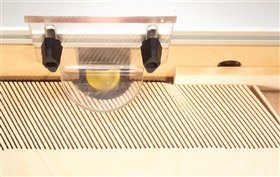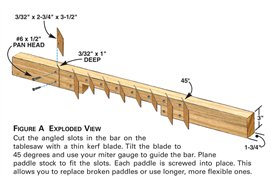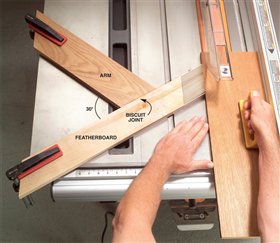We may receive a commission when you use our affiliate links. However, this does not impact our recommendations.

Tips for Mastering Featherboards
Featherboards
are like having an extra set
of hands in the shop,
going where
no fingers
ever should.
By Jock and Susan Holmen
The featherboard gets its name from the rows of
flexible “fingers” that act like a bird’s feather and
give way in one direction only. They help ensure
safety and accuracy, because they keep consistent
pressure on stock where it’s needed most, close
to the cut. They’re indispensable for eliminating
bumps on a molded edge or uneven bottoms in
rabbets and dadoes.
Shop-made featherboards are often superior to
commercial ones, because they can be custom fit
to your machines and they cost next to nothing.
All the featherboards in this article were made
from the type of scrap lumber and plywood that
can be found in any shop.
Perfect pressure every time
Positioning a featherboard can be a pain.
Too close to the fence or table and the squeeze
is so tight you can barely feed the stock. Too
loose and you’ve lost effectiveness. Try taking
about 1/8 in. off the first feather. Set that end
against the stock you plan to machine and
clamp the featherboard parallel to the table’s
fence. The pressure should automatically be
just right.
|
|
Click any image to view a larger version.

|
Featherboards made easy
The safest way to make featherboards is on the bandsaw
using a simple sled with a miter slot runner. Cut a 30-degree
angle on one end of the featherboard blank first. Mark a
parallel line about 2-1/2 in. from the angled end. Set the
blank on the sled and make the first cut from the end to the
line. Then, slide the featherboard over to the next mark to
make the second cut and continue across the board’s
width.
A feather length of about 2-1/2 in. with cuts made every
1/8 in. provides the right balance between flexibility (for
firm pressure without being too stiff) and strength (so the
feathers won’t snap off) for most hardwoods or multi-ply
birch. Increase the feather spacing to 3/16-in. when you
are using softer woods, such as pine or basswood, or regular
hardwood plywood. You can always fine-tune the length
and spacing to suit your own needs.
|
|

|
Tall support for tall stock
A tall featherboard can apply pressure
against the entire height of the
fence. It’s especially useful for holding
tall, narrow stock—for instance, a
door panel—against a fence. Just glue
some scraps to create a block that is as
tall as your fence is. Then, cut the
feathers on your bandsaw sled.
|
|

|
Bit-bridging featherboard
This wraparound featherboard produces
chatter-free moldings, because it provides
continuous pressure ahead of and behind
the cutter. Cut a 2-in. arc in the end of the
blank before you cut the feathers.
|
|

|
Guaranteed square edges
Jointing an absolutely square edge on a wide
board can be tricky for someone new to the
jointer. The least little tip away from the fence
and you’ll have to start over. This paddle-style
featherboard can bridge your jointer’s guard
while keeping your stock pushed firmly against
the fence. The paddle featherboard is easy
to make and is just as useful on
a tablesaw or router table
(Fig. A, right).
|
|


|
Quick, easy featherboard fasteners
Clamping a featherboard on a tablesaw
can be a hassle. T-track fasteners allow you
to quickly and easily position a featherboard
just ahead of the blade for rip cuts.
To make this style of featherboard, cut
deep slots for the T-track fasteners as you
cut the feathers on your bandsaw.
|
|

|
Short-fence featherboard
Sometimes you want a featherboard to apply pressure right over the blade, as
when you’re cutting a rabbet. But clamping a long, narrow featherboard onto a
short fence can give you fits. This long plywood featherboard is just the ticket.
It clamps easily onto the squat tablesaw fence because the clamps are far
removed from the feathers and the blade.
Most featherboards are made with the feathers parallel to the grain, but this
one requires the feathers to be cut across the grain. Be sure to make it from plywood
or your cross-grained featherboard will start to look like my 8-year-old’s
smile—lots of missing teeth. To cut these feathers, use the same sled as you do
for the parallel-grain boards, but add a 30-degree wedge.
|
|


|
Long-reach featherboard
A long arm on a featherboard
takes the hassle out of clamping
it on a tablesaw. Featherboards
need to be secured at two points
to prevent pivoting. Securing a
single featherboard across a
tablesaw’s large expanse can be
difficult, if not impossible. The
solution is to biscuit an arm at a
30-degree angle to the featherboard.
Position the featherboard
just in front of the blade for rip
cuts.
|
|

|
Product Recommendations
Here are some supplies and tools we find essential in our everyday work around the shop. We may receive a commission from sales referred by our links; however, we have carefully selected these products for their usefulness and quality.



















